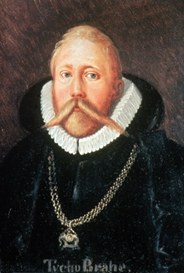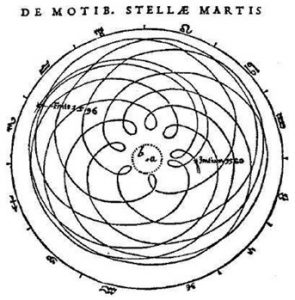Most people would think that the death of their long-time mentor would put a halt to life as they know it. However, that was not the case for German astronomer Johannes Kepler. The death of his long-time friend and research partner, Tycho Brahe, allowed Kepler to finally dive into his own separate avenue of research. Kepler was finally allowed to openly pursue his ideas for the physical causes of planetary orbits.
Johannes Kepler was born on December 27, 1571, in Weil der Stadt, Württemberg (Germany). Growing up, Kepler was raised around a multitude of scientific experiences. Starting from the age of six, Kepler slowly started to involve himself in astronomy, which would lead him to a lifetime passion for it. Growing up, Kepler attended Tübingen Stift, a well-known Protestant seminary within Württemberg. While there, Kepler was taught the Ptolemaic and Copernican systems of planetary motion. It was during this time that Kepler was converted to the Copernican system.1
While growing up, Kepler was raised in a budding era when a new astronomy was emerging out of an older one, and he was destined to play a role in shaping that new astronomy by challenging fundamental assumptions that were long held to be the foundations of our understanding of nature itself. The cosmology of Kepler’s time was based on a concept of nature that assumed that all things contained within them qualities of perfection. The cosmos was composed of elements that made up every possible grade and degree of perfection, from the most perfect of things to the least perfect of things, and everything was linked so that there were no missing links in the “great chain of being.” Taken as a totality, the universe itself was perfect, because it contained all things needed for a perfect universe. If there were missing links in the “great chain of being,” then it wouldn’t be a perfect universe, because it would be missing something it should have. Thus, each thing in the universe was thought to have a certain amount of perfection, and each thing would express its quantum of perfection through its essential expression or its nature, or, as Aristotle explained it, things manifested their “final causes,” which are expressions of their levels of perfection. The ancient Greeks divided the cosmos into two realms, the celestial realm and the terrestrial realm. The terrestrial realm, here on earth, contain elements that are lower in the great chain of being. Therefore, motion in the terrestrial realm was imperfect motion, or chaotic and random motion. But motion in the celestial realm, where the sun, planets, and stars resided, was thought to be of the highest degree of perfection. And the ancient Greeks believed that that motion must be circular motion, because the circle was the geometrical symbol of perfection. Thus, planetary motion in the celestial realm was thought to be circular motion because in that realm, all elements had extremely high levels of perfection within them. They moved according to their qualities of perfection. This was the worldview assumption behind Claudius Ptolemy’s famous work on astronomy in the second century CE, which was the basic teaching on planetary motion for scholars throughout the middle ages up to Kepler’s day. It was this qualities of perfection assumption that Kepler himself believed as he started his career. And as a Christian in the sixteenth century, Kepler and his colleagues believed that God was the author of this universe that was made up of qualities of perfection, with God Himself being the highest link in that great chain of being.2
The Ptolemaic system thus viewed the earth to be motionless at the center of the universe, and thus the furthest removed from the source of all perfection, God. By 1543, the Polish astronomer Nicolaus Copernicus revised the Ptolemaic system, changing the planetary motion to be solar-centric, but he maintained the qualities of perfection assumption of the Ptolemaic system in doing so. Copernicus’s goal was to revise Ptolemy’s system so that it made movement in the celestial realm more harmonious and more consistently circular than Ptolemy had. He was the one to place the sun at the center of the universe, making it the focal point. Copernicus thought that if he were to make this change, he would be able to reduce the number of epicycles (variation of speed and direction in motion concerning a planet) and eccentric orbits (an orbit that is not close to the shape of a circle) that were anomalies in Ptolemy’s system.3

Kepler’s life changed on February 4, 1599, when he met Tycho Brahe for the first time. At this time, Brahe was one of the most well-known astronomers alive. For years, Brahe used his observatory to collect data on the movements of the sun, moon, stars, and planets, believing that if Copernicus was right, then Ptolemy’s data was woefully out of date and incomplete. He gathered information on the the position and movements of many planets for years.4 And this data would be crucial to Kepler in the years to come. The meeting between Kepler and Brahe was an odd, yet fateful event. Kepler had traveled to Prague to leave the oppressive atmosphere he had been experiencing in Graz, and to meet the renowned Tycho Brahe. In Graz, the political and religious tension had been rising between Protestants and Catholics. With the emperor’s health starting to decline and Catholics attempting to reconvert Protestants, Kepler, a Protestant, realized that it was time to leave. While in Prague, Kepler tried to persuade Brahe to allow him to work alongside Brahe in his research. Luckily for Brahe, he had been on the lookout for help and became extremely interested in Kepler and in his opinions. Although Brahe was looking for someone to help in research, Kepler wanted to use Brahe’s data in order to supplement the data he had already acquired. Kepler had some competition when it came to trying to work with Brahe. He was up against nine other men who all had a lot to bring to the table. Kepler had the advantage though, because he had been able to publish his first book in 1596, Mysterium Cosmographicum. This was an astronomical book that defended the systematic portion of the Copernican system. Prior to working with Kepler and allowing him access to his information, Brahe had experienced untrustworthiness with some of his assistants. In 1580, the assistants of Brahe had shared his observations with others within the field, with his competition, so to speak. From then on, Brahe had made a promise to himself to never let anyone touch his observations again. That promise, however, when applied to Kepler, would hold Kepler back in the research he was planning on doing. Brahe was hesitant to share his information with Kepler, but finally agreed to let him use some of his data on one planet for his research. Kepler was then given most of the information collected on the planet Mars.5
Although Kepler was given most of the information on the movement of Mars, it was still not enough for Kepler to do his research. He became quickly frustrated from the lack of information and the mistrust he continued to face from Brahe. Kepler wanted to see the data on the other planets that Brahe had data on. Brahe had limited Kepler to just the data on Mars. Brahe also had his long-time assistant, Longomontanus, watch a lot of Kepler’s moves, and he made Kepler sign a confidentiality form. This form was a promise that Kepler would not discuss what he was working on with anyone, or the data that he was using during this time. Though experiencing some trouble, he was still able to get crucial research done. Brahe was using Kepler to find the mathematical aspect of all the observations he had picked up along the way. For the next year, Kepler looked at the data on Mars’ orbit. He was able to find errors that Brahe had committed when he himself had been working on the Mars observations. Right when everything started to finally go right for Kepler and Brahe, tragedy struck Prague. Tycho Brahe unexpectedly died on October 24, 1601. His death left panic within the city and at the observatory. Questions began to flare up among Brahe’s assistants and among those who were involved at the observatory. Two days after Brahe’s death, Emperor Rudolph II appointed Kepler to be Brahe’s successor to all of Brahe’s work, as well as becoming the Imperial Mathematician. At this time, this was the most prestigious appointment one could get as a mathematician. Despite experiencing something as traumatic as losing your mentor, Kepler was finally able to be set free from the restraints that Brahe had put on him. He was able to look at all of the data that he had not had access to before, and he now began using that data to work on his own project, one separate from the project Brahe had assigned him.6

While working on the data for the motion of Mars, Kepler kept a notebook of his observations and thoughts in late 1601 and early 1602. He noticed an anomaly in the data that he couldn’t explain. Now that he had access to all the observations Brahe had been collecting, he could see the problem more clearly. He realized that the data was telling him that the speed of Mars was not consistent for maintaining a circular orbit. Of course, he assumed that the data must be describing a circular orbit, as it was a fundamental assumption that in the celestial realm, circular orbits were God’s mark of perfection for those links in the great chain of being. By March of 1602, Kepler kept going back and forth between all of the observations and necessary equations those observations demanded to figure out where the data was going wrong. He finally took a step back and looked at the data again. He created a table to try and mark different points in the orbit of Mars and its distance from the sun at those points. This table became the data that Kepler used to create a variety of different angles of the orbit. It was at this moment he found where he had gone wrong. He had noticed that Ptolemy’s theory was too fast in the curves of the orbit, yet too slow on the straights. He saw that within the orbit itself, the path of Mars was too short within the middle portion to present a perfect circle. He came up with a number of hypotheses to explain the anomaly, a number of “what if we did this” and “what if we assumed that.” In one of his hypotheses, Kepler even saw that the result of such a “what if” would result in Mars making an oval path, which he, of course, dismissed as an impossibility. He tried another hypothesis, and it too forced him to conclude that such an approach to the data would again lead him to conclude that Mars was not following a circular orbit. Scholar William Donahue sums up Kepler’s attempts this way: “The evidence is recognized [by Kepler] as leading to an oval, but that only suggests that some way must be found to accommodate both the evidence and the presuppositions.”7 Kepler’s presuppositions here were that planets moving in the celestial sphere must be making perfect circular orbits, because their quality of perfection demands it. Kepler had this idea of a possible oval shape, as we saw earlier, but because of the qualities of perfection assumption, he refused to see what the data was showing him.8

Kepler kept at the problem until the end of March and into early April. He began to question why there was an oval shape within the orbit of Mars when that simply couldn’t be the case. Kepler laid out the drawings he had made of the orbit. Alongside the drawings, he put the equations and data right next to it. Instead of accepting the idea of the oval-shaped orbit, Kepler changed the different angles within the drawings and data. Within the drawing, Kepler had marked out the data points from the table. With the sun as the focal point, Kepler placed different points around the sun to demonstrate where Mars was at those points. Kepler realized though, that if he demanded that the data maintain “the perfect circular orbit,” he would have to change the angle of these points up to five degrees of their actual placement. Even then, it would not be enough the make circular orbits happen. He would end up right back where he started, with a slightly oval orbit.9
Kepler took a step back and started to think, rather than just analyzing the data. This is when he finally stopped being blind from his insistence in the implications from the qualities of perfection worldview. He realized that there was no way to make the orbit of Mars follow a perfect circle. He didn’t know why is wasn’t circular, but he finally stopped denying what the data was showing him. This was a major breakthrough for Kepler, and for modern science. It was a major first step in breaking with a worldview that had kept astronomers from understanding actual planetary motion for centuries. Kepler would go on to explain this experience in a letter to an old friend. He compared his experience to one in Proverbs, the story of the hasty dog bearing blind pups. He expressed how he had been too stubborn to let go of the celestial realm being the realm of perfection, and how that had blinded him from seeing what was right in front of him. He finally accepted the data, and that acceptance had major implications for his future research and for what we have come to call The Scientific Revolution. Kepler continued to believe that God was the author of the universe, and that God had made it a perfect universe. It just wasn’t the kind of perfection that the great chain of being worldview had generated.10
After Kepler’s discovery of oval orbits, he went on to discover that the type of oval he was seeing was in fact an ellipsis. That discovery led him to see the perfection in God’s creation, which he subsequently articulated in his three laws of planetary motion. It was in the mathematical equations that described elliptical motion where Kepler saw the kind of perfection of God’s handiwork that he had wanted to see in circular planetary motion. He would go on to publish all of his observations and equations in his book the Astronomia Nova in 1609. For the rest of his life, Kepler continued to make countless discoveries, such as his three laws of planetary motion, all of which would be published in numerous books. Kepler died in 1630 on the way home from collecting an old debt. Unfortunately, within two years of his death, his grave was demolished during the Thirty Years’ War.11 Kepler would go down as the pioneer to many new scientific ideas. All of Kepler’s discoveries would help contribute to the “The New Astronomy.” Without his discovery of the elliptical orbit, who knows what would have happened. Though someone might have made this discovery, it would have changed everything, especially the formation of the New Astronomy. It may have been that without the death of Tycho Brahe, Kepler would have never been granted all of the observations Brahe was hiding. There are so many questions that could not have been answered without Kepler and the death of Brahe. Kepler was one of the pioneers of the New Astronomy. Kepler was the first person to understand God’s perfect creation in a new way. It wasn’t based on qualities of perfection, but was expressed in mathematical equations.
- Ronald F. Smith, “Johannes Kepler,” in Salem Press Biographical Encyclopedia (Salem Press, 2020). ↵
- Alan Kors, “Lecture 4: The New Astronomy and Cosmology,” The Birth of the Modern Mind (The Teaching Company, 1998); Bradford Whitener, “The Scientific Revolution and the European Enlightenment,” History 2322: World History since 1450 (class lecture, St. Mary’s University, San Antonio, TX, February 4, 2022. ↵
- When it comes to eccentricity, astronomers used a scale from zero to one, zero showing that an orbit was perfectly circular with the sun directly in the center of that orbit. Any fraction from zero to one would place the sun off-center and the orbit would bend the circular orbit into corresponding degrees of oval shaped orbits; see Alan Kors, “Lecture 4: The New Astronomy and Cosmology,” The Birth of the Modern Mind (The Teaching Company, 1998). ↵
- Ronald F. Smith, “Johannes Kepler,” in Salem Press Biographical Encyclopedia (Salem Press, 2020). ↵
- James R. Voelkel, The Composition of Kepler’s Astronomia Nova (Princeton University Press, 2001), 97-101. ↵
- Ronald F. Smith, “Johannes Kepler,” in Salem Press Biographical Encyclopedia (Salem Press, 2020). ↵
- William H. Donahue, “Kepler’s Approach to the Oval of 1602, From the Mars Notebook,” Journal for the History of Astronomy 27 (1996): 289. ↵
- James R. Voelkel, The Composition of Kepler’s Astronomia Nova (Princeton University Press, 2001), 138. ↵
- William H. Donahue, “Kepler’s Approach to the Oval of 1602, From the Mars Notebook,” Journal for the History of Astronomy 27 (1996): 289. ↵
- James R. Voelkel, The Composition of Kepler’s Astronomia Nova (Princeton University Press, 2001), 140-141. ↵
- Alan Gould, “Johannes Kepler: His Life, His Laws and Times,” Text, NASA, September 24, 2016. ↵



6 comments
Halie Estrada
Hi loved your article! I have never really understood astronomy and its origins and your article was very helpful in that aspect. Your article was by far my favorite because I am always trying to broaden my knowledge inside and outside of the classroom by reading these types of articles and you did a great job simplifying something so complex!
Robert Miller
This article reminded me of a quote “When Kepler found his long-cherished belief did not agree with the most precise observation, he accepted the uncomfortable fact. He preferred the hard truth to his dearest illusions, that is the heart of science.” – Carl Sagan. This is a great article about who I think are the pioneers of space observation.
Esteban Serrano
Hi Jesslyn, great work on the research and article! I have seen and read about Kepler plenty of times, in which I remember the most from the remake of “Cosmos,” with Neil DeGrase Tyson. The Catholics and Protestants and astronomers controversy really did make me interested in the history of how these men discovered the things that they did. In midst of hatred because of belief in God at the time, science was secondary. Nonetheless, Kepler, being one of few to discover new ideas about the universe around this time, persevered in his studies of such and made the ideas into the universe we study today.
Ryan Romine
This was such an interesting article. I did not know about Brahe or Kelpler but I was very interested in learning about their relationship and the work and ideas they had. I have always been interested in astronomy but never looked deeper into it. I may after this article.
Ben Kruck
I enjoyed reading your article! I learned a bit about Tycho Brahe and Johannes Kepler in my astronomy class back in high school, but this goes into a lot more detail than my astronomy class did. I’ve always shown some interest in astronomy and its history, so I was curious to see what this article was about. I like the way you presented this article; it gave off a professional feeling!
Kelly Arevalo
Loved your article! I have never studied or heard about most of what you are describing in your article, truth to be told, but I think I got to understand the concepts you were describing. I like how you were able to simplify such a complex topic and the way you presented both the scientific research, and the philosophical background. Nice work!